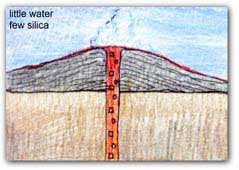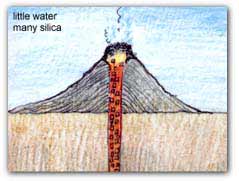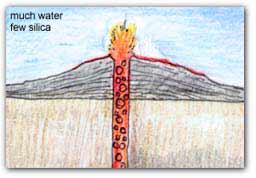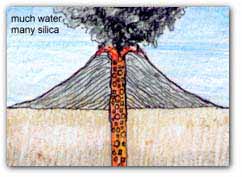|
|
What happens in eruptions |
These diagrams show what happens in an eruption. An eruption begins when pressure on a magma chamber forces magma up through the conduit and out the volcano's vents.
What happens in
eruptions
![]()
These diagrams show what happens in
an eruption. An eruption begins when pressure on a magma chamber
forces magma up through the conduit and out the volcano's
vents.
When magma reaches earth's surface it is called lava. It may pour out in gentle streams called lava flows or erupt violently into the air. Rocks ripped loose from the inside of the volcano or torn apart by the gas may be shot into the air with the lava. These rocks blown out of a volcano are called pyroclastic rocks. The rock fragments fall back to earth in many different shapes and sizes.
The amount of silica determines how sticky (level of viscosity) the magma is and whether it is runny or not. Water makes steam and makes the lava explode.
 1.
not much water, and not much silica - this means runny lava
flows that just run down the side of the volcano.
1.
not much water, and not much silica - this means runny lava
flows that just run down the side of the volcano.

2. not much water, but lots of silica - this makes sticky
lava and it often builds domes rather than running down the
sides.
Obstacles also influence the type of
eruption. When the pipe is blocked by rocks or pumice, the
pressure in the pipe will build up very high, resulting in an
explosion.

3. lots of water, but not much silica -
this will make a fountain of runny lava that spurts out the
top

4. lots of water, and lots of silica (making it very sticky)
- this makes the kind of volcano that is a huge
explosion